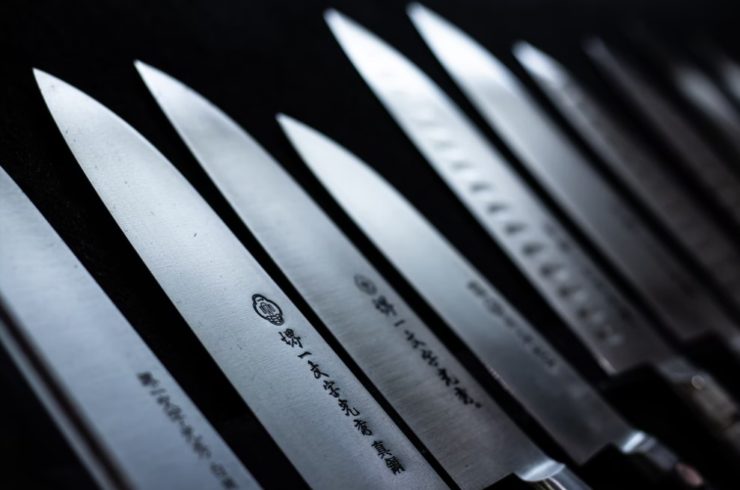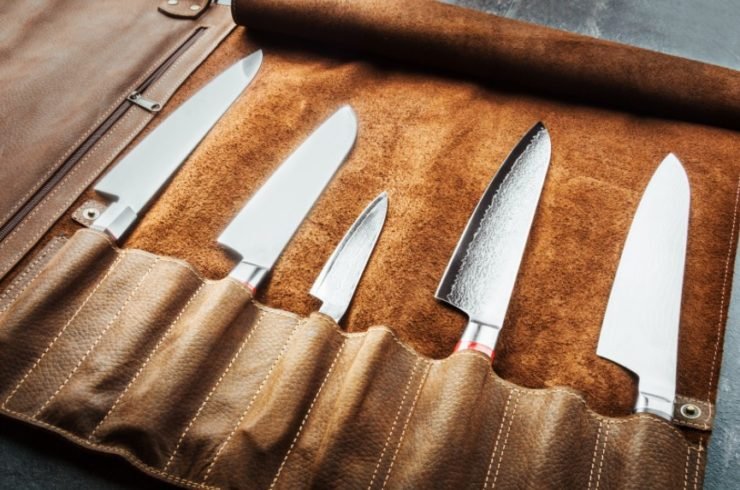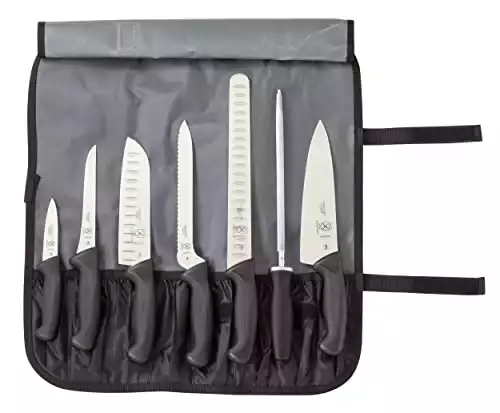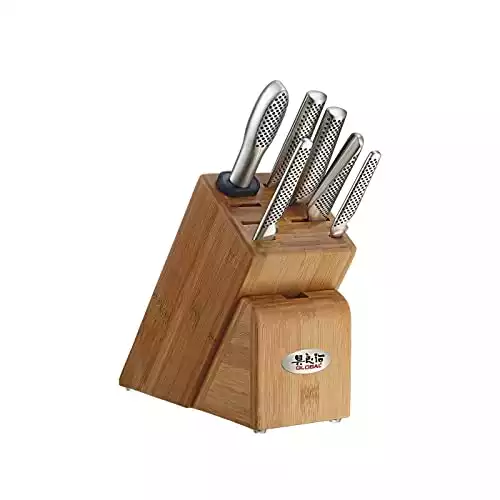Choosing a chef knife set for culinary school is an exciting endeavor. But, it can be a difficult and confusing task.
You’ll learn A LOT about knives on the cooking journey you’re about to embark on. But for now, you might only have a vague idea about knife brands, types, and materials. Plus, most of these lists are written by folks who have never been in your shoes.
I’ve been there, done that, and frankly, did it all wrong. So now, hopefully, I can help you avoid the mistakes I made by highlighting the best knife set for culinary school, and everything you need to know to get cooking on the right foot.
In This Article
Best Overall: Victorinox Fibrox Pro 7pc Set
The Fibrox Pro set from Victorinox is the best knife set for embarking on your culinary school journey. It’s a great and inexpensive option for beginners, but it will continue to serve you well once you move on to a professional kitchen.
When it comes to culinary school knives, simple is better. You should be able to focus on learning and cooking rather than worrying about damaging or losing a thousand-dollar knife set.
There are no fancy wood handles with bone collars here, and that’s a good thing. These knives are made with simple and durable polyamide-coated handles. That’s a heat-resistant plastic that’s comfortable and offers excellent grip even when wet.
The Fibrox Pro blades are stamped from cold-rolled steel, rather than forged, like many higher-end options. This is another reason the set is so affordable, and also a better option for beginners.
The stamped blades are softer than their forged counterparts. So, while they may not stay as sharp for as long, they are easier to sharpen, and honing is more effective. Two crucial elements when you’re learning how to use and maintain your cutlery.
This 7-piece set has all the knives you’ll need for practicing knife cuts, or breaking down fish, meat, and poultry. Plus, the knife roll helps keep everything organized and easy to transfer from home to class.
Overall, this is an incredibly functional set, not a flashy one. They’re perfect knives to learn with. But, I also know many pros (myself included) who keep them around for heavy-duty tasks, because they’re so easy to keep sharp.
What we like
- Very affordable
- Durable handles
- Blades are easy to sharpen and maintain
- Knife roll included
What We don’t
- Edge retention isn’t the best
Best Value: Mercer Culinary Millennia 8pc Set
The Mercer Millennia knife roll set has a lot of similarities to my Victoronix pick. The fit and finish are not quite up to par, but at around $75 less, this is an incredible value that will still get the job done.
Similar to Victorinox, this set is built from stamped steel and has heat-resistant plastic handles. These handles also have rubberized, textured inserts for added grip.
The high-carbon stainless steel blades can take a sharp edge, but they are on the softer side. That means they will need to be sharpened more often, but sharpening is relatively easy.
The 8-piece set has all of the knives you’ll need to get through school, as well as a knife roll that makes storing and transporting your knives easy.
This set also includes a couple of knives that don’t necessarily come standard with other beginner sets. A santoku and a 10-inch scalloped slicer.
While neither of those is necessarily required, they are nice additions that can come in handy in specific situations.
But, my favorite knife in this set is the offset bread knife. This has a raised handle that helps keep your knuckles from hitting the cutting board. A common problem with bread knives in particular.
While the Mercer and Victorinox sets are very similar, I’ve found the overall build quality and feel of Victorinox to be slightly better. But, if you’re on a tight budget, Mercer is a worthy choice.
What we like
- Very inexpensive
- Includes a slicing knife and santoku
- Knife roll included
What We don’t
- Must be sharpened often
Best Upgrade: Global Takashi 7pc Set
This 7-piece knife set from Global costs more than double my other top picks. But, it packs performance, durability, and exceptional balance into knives that look plain cool.
These Global knives are made from stamped steel and are made entirely in Japan. One of the great things about the steel that Global uses is that it holds an edge for a long time, but is still easy to get razor-sharp.
The steel and blade life is great, but it’s the design of these knives that really set them apart and make them a great choice to get through culinary school.
The knives look like the blade and handle are made from one continuous piece of metal. But, they are actually made separately and then joined together without any seams or weak points.
That means there’s no wood to crack and no plastic that’s going to melt or get scratched up, leaving an uncomfortable handle. These stainless steel handles also feature shallow dimples that do a good job of adding grip, even when wet.
The smooth transition from blade to handle is very comfortable to hold and work with. This design is great for beginners and will make it easier to get comfortable with the “pinch grip” that you’ll no doubt be taught to use.
Another significant difference with this set is that it comes with a ceramic sharpening rod, rather than a classic honing steel.
A honing steel re-aligns your blade but it doesn’t actually sharpen it. A ceramic rod, on the other hand, removes metal from your knife, which means it is actually sharpening as you use it.
A ceramic rod isn’t a replacement for regular knife sharpening, but it can certainly help keep your blade sharper for longer.
The Global Takashi set is pricey compared to my other picks. And, the included knife block isn’t going to do you much good in the classroom, so you’ll still need to pick up a soft case or roll separately.
But, these knives have great edge retention and handles that won’t get damaged or break. Plus, this is a set that you won’t quickly outgrow and will be by your side well into your professional career.
What we like
- Handles are comfortable and easy to learn the proper form with
- Good edge retention
- Ceramic rod is an upgrade from a honing steel
What We don’t
- On the expensive side
- No knife roll included
Runners Up: Not Necessarily For Beginners
The Unnecessary Upgrade: Shun Classic 8pc Set
These are basically the knives I went through culinary school with. Which was silly, because my tuition already included a perfectly good set that was handed out on the first day of class.
The Shun classic knives have very comfortable handles and come wicked sharp, straight out of the box. Plus, the Damascus cladding looks cool.
The VG-10 blades are very hard, so it offers great edge retention. But, it’s also very difficult to sharpen, which can be frustrating and time-consuming when you’re just learning the ropes.
If I could do it over again, I would have saved the money and stuck with the standard-issue set from school.
The Graduation Gift: Misono UX10 8-Inch Gyutou
If graduation gifts are on the table, ask everyone to pool together and get you this knife. The beginner knives that got you through school are still useful tools, but the Misono UX10 is the ultimate daily driver.
This is a Japanese knife, but the blade is made from Swedish steel. The whole thing is lightweight and perfectly balanced. And, the thin but strong blade is perfectly suited for everything from vegetable prep, to breaking down fish, or even whole animal butchery.
You can also go with the Misono Molybdenum Gyutou, the very respectable and much less expensive sibling. But be careful, these are gateway knives when it comes to high-end Japanese cutlery.
Buyers Guide: Choosing The Best Chef Knife Set For Culinary School

The Knives You’ll Need
While each culinary program is different, it’s fairly common for them to provide a starter knife set to each student. If that’s not the case, you’ll want a few specific knives so that you can learn how to use them properly before you’re actually cooking in “the real world”.
At the very minimum, you’ll need a chef’s knife and a paring knife. You can go far with just these two knives, and you’ll want to get VERY comfortable with both.
A boning knife and a fillet knife are somewhat specialty items and depending on where you are, you may not use them all that often. These are both knives that are good to get experience with in culinary school but probably won’t get much use on a daily basis when cooking at home.
Now a bread knife is almost the opposite. Incredibly useful for cutting baked goods at home, but not something that will be called upon very often in school.
Those five knives, plus a honing or sharpening rod should get you through just about any class that you encounter.
Knife Anatomy: Know What To Look For
Understanding some key parts of a knife will help you better understand your options and make the best choice.
Blade Material
While knives are made from a wide range of materials and various combinations of metal, there are two primary types that you’ll be choosing from. Stainless steel and carbon steel.
Stainless steel, as you may have guessed, is resistant to rust and corrosion. This is the option I recommend for beginners because they require less maintenance and are generally easier to care for.
Carbon steel knives, on the other hand, are harder, more brittle, and very susceptible to rust. These knives can take a more keen edge and will stay sharper longer, but they can also be prone to chipping and must always be kept dry to protect from rust.
Bolster
The bolster is where the handle meets the blade. A larger bolster adds weight and can also help protect your fingers from the heel of the knife. Large bolsters are more common on German-style knives but have become somewhat outdated. They make it hard to use the entire blade and make sharpening more difficult.
Knives with a smaller bolster are lighter, more comfortable to hold, and easier to sharpen. But, they don’t provide much protection from the heel of the knife.
Tang
The tang is the metal of the knife blade that extends into the handle. A full-tang means that the blade metal runs through the entire handle. A full-tang adds durability, and balance to a knife but can also make it weigh and cost more.
Then you have semi-tang and no-tang options. Semi-tang has metal that extends partially into the handle for some added durability as well as cost savings.
No-tang knives are almost always the least expensive option, and are also the most likely to fail and break.
Handle
Knife handles are made from a variety of materials, with wood and plastic being the most common. But, there are also options made from metal, bone, and rubber.
Handles also come in several different shapes and play a large role in the overall feel of a knife. If you can, try to get some hands-on experience with any knife before you buy it since hand feel is a very personal preference.
Storage: Protect Your Investment And Your Fingers

A knife bag or roll is basically a requirement for culinary school. It doesn’t need to be anything fancy, but a way to transport your knives in a safe and organized way is a no-brainer. And, no matter how durable a knife bag claims to be, I would strongly recommend using edge guards as well.
This will keep your knives from poking through and damaging you and your bag. And, it will keep your knives from banging into each other and dulling the blades.
Knife Maintenance
Taking care of your knives really comes down to two things. Keeping them dry and keeping them sharp.
Even a stainless steel knife can rust if it’s left dirty or wet for too long. Try to get in the habit of drying your blade after every cutting task and especially before storing them in a bag or block.
Now, keeping your knives sharp can take a bit more effort.
Honing your knives is a simple task that’s useful in between sharpening, but it’s not a replacement.
The best thing you can do is to do maintenance sharpening before your knife is dull. This kind of upkeep is fast and easy. But, if you wait too long, you’ll need to put a new edge on your knives, and that can take a lot of time and effort.
The common and maybe most important thing that all of my top picks have in common is that they are all relatively easy to sharpen.
Choosing incredibly hard steel might seem like a good idea at first. But, it is much more difficult to sharpen, especially when you don’t really know what you’re doing yet.
What You’ll Pay & And How Long They Will Last
Buying all the knives you need for culinary school doesn’t have to cost a lot. Even if you’re starting from scratch, my best overall and best value pick both come in well under $200. And, even those options should last into your professional career, well past graduation.
My upgrade pick, at around $400 might seem steep, but it’s still on the low end when it comes to professional kitchen knives. And, if they’re not abused, those knives will last a lifetime.
Now, it’s also very easy to spend a whole lot more. But my advice, wait.
As you work in the industry, your taste in knives as well as your needs and skills will change. And as they do, you can start upgrading and adding specialty pieces to build up your collection as you need and also just for fun.
My personal collection has grown significantly since my culinary school days. And while some older pieces have been given away to cooks in need or lent to family members, many have become what some cooks call their “beater knives”.
Your backup set that’s saved (and still loved) for breaking down lobsters, chopping nuts, or other tasks that aren’t worthy of the razor edge on your newer additions.
My Recommendation
Any knives you buy, whether you’re a home cook, culinary student, or a pro should be of high quality. But, that doesn’t mean they have to break the bank.
The Victorinox Fibrox knives are really hard to beat when it comes to well-made knives that are affordable. I think this is the smartest choice for most new culinary students. You’ll still find a couple of these in my kit, right next to knives that cost 10 times as much.
The Global set costs more than double, but it offers better edge retention while remaining easy to sharpen. The design and feel is also top-notch, so you’ll be happy to use these well into your cooking career.
FAQs
Should My Culinary School Knives Be Different Than The Ones I Use At Home?
The knives you use for culinary school should be high-quality ones that you are comfortable with and enjoy using. The same goes for the knives you use at home.
Having one set for home and one set for school is convenient but not necessary. If you only have the space and money for one, that’s totally fine. You’ll just end up packing and unpacking them more often, and you may need to sharpen them a little more frequently.
Does It Matter If I Get German Or Japanese Knives?
The German or Japanese knife debate is a very personal one. If you can, try several different options and see which feels the best to you.
How Important Is Hand Feel When Choosing A Knife?
Very important. The knives you choose will be in your hands for hours a day. You definitely want something that feels good and that you want to use. Again, if you can, try out several different knives in person before making a purchase.
Should I Learn To Sharpen Myself Or Get It Done By A Professional?
You should definitely learn to sharpen your own knives. Home cooks can get by having their knives sharpened only a couple of times a year. When you’re cooking for a living, it’s a whole nother story.
It will vary from kitchen to kitchen and station to station, but it’s common to need to sharpen your most used knives on a weekly basis or even more.
That would be a lot of money and a lot of time without your knives. Plus, many “professional” sharpeners use aggressive grinding wheels. These are great because they’re fast, but they also take away a lot of metal and shouldn’t be used on a regular basis.
What Other Equipment Does Every Culinary Student Need?
Knife kits can quickly get cluttered when you start adding accessories and utensils. But, a good pair of kitchen shears, a vegetable peeler, and a sharpening stone are three must-haves to round out your kit.










